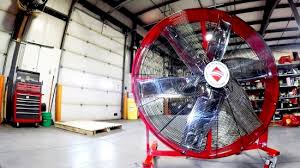Large industrial fans are essential for maintaining proper air circulation, ventilation, and temperature control in warehouses, factories, and other commercial spaces. Regular maintenance is crucial to ensure these fans operate efficiently, reduce energy costs, and extend their lifespan. This article provides essential maintenance tips to keep large industrial fan running smoothly for years to come.
1. Regular Cleaning and Dust Removal
Dust, dirt, and debris can accumulate on the blades and motor housing, reducing efficiency and increasing strain on the fan. Regular cleaning is necessary to maintain optimal performance. Follow these steps:
-
Turn off and unplug the fan before cleaning.
-
Use a soft brush or compressed air to remove dust from blades and vents.
-
Wipe down the blades and housing with a damp cloth.
-
For stubborn grime, use a mild detergent and water solution.
2. Inspect and Tighten Fasteners
Over time, vibrations from continuous operation can loosen screws, bolts, and other fasteners. Regularly check and tighten all components to prevent excessive wear and tear.
-
Inspect the mounting hardware and brackets.
-
Tighten loose bolts and screws using appropriate tools.
-
Ensure fan blades are secure to prevent wobbling and imbalance.
3. Lubricate Moving Parts
Proper lubrication reduces friction and prevents premature wear of moving parts such as bearings and motor shafts. Follow manufacturer recommendations for lubrication intervals and approved lubricants.
-
Apply lubricant to bearings as specified in the user manual.
-
Avoid over-lubrication, as it can attract dust and debris.
-
Use high-quality industrial lubricants designed for heavy-duty fans.
4. Check and Replace Belts and Bearings
Belts and bearings are critical components that require routine inspection and replacement when worn out.
-
Inspect belts for cracks, fraying, or looseness.
-
Replace worn-out belts to maintain proper tension and efficiency.
-
Listen for unusual noises that may indicate worn-out bearings.
-
Replace faulty bearings to prevent motor strain and overheating.
5. Monitor Motor Performance
The motor is the heart of an industrial fan. Regular monitoring can prevent breakdowns and costly repairs.
-
Check for overheating or excessive vibration.
-
Listen for unusual sounds such as grinding or buzzing.
-
Test motor efficiency by measuring amperage and voltage levels.
-
Schedule professional inspections for in-depth diagnostics.
6. Balance the Fan Blades
Unbalanced fan blades can lead to uneven airflow, excessive vibration, and motor strain.
-
Inspect blades for damage or warping.
-
Adjust or replace blades to maintain balance.
-
Use a balancing kit if necessary to ensure smooth operation.
7. Ensure Proper Electrical Connections
Faulty wiring or loose electrical connections can cause power fluctuations, reducing efficiency and increasing safety risks.
-
Inspect power cords and connections for wear or damage.
-
Tighten loose electrical terminals.
-
Schedule professional electrical inspections for safety compliance.
8. Check Airflow and Ventilation
Proper airflow ensures the fan operates efficiently without excessive strain.
-
Remove obstructions around the fan.
-
Clean air intake and exhaust vents.
-
Adjust fan speed settings based on environmental needs.
9. Conduct Routine Inspections
Regular inspections help identify potential issues before they become major problems.
-
Schedule monthly visual inspections for wear and tear.
-
Perform annual deep inspections, including motor performance tests.
-
Keep a maintenance log to track inspections and repairs.
10. Follow Manufacturer’s Guidelines
Each industrial fan model has specific maintenance requirements outlined by the manufacturer.
-
Read and follow the user manual for maintenance instructions.
-
Use recommended replacement parts and lubricants.
-
Adhere to manufacturer-recommended service intervals.
Conclusion
Regular maintenance is essential to keep large industrial fans operating efficiently and prolong their lifespan. By following these maintenance tips—cleaning, lubricating, inspecting components, and ensuring proper balance—you can prevent costly repairs and downtime. Investing time in routine maintenance will ensure optimal performance, energy efficiency, and long-term reliability of your industrial fan.
